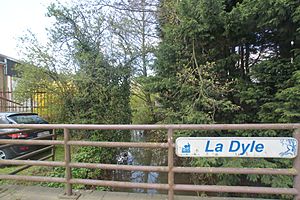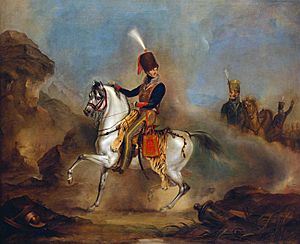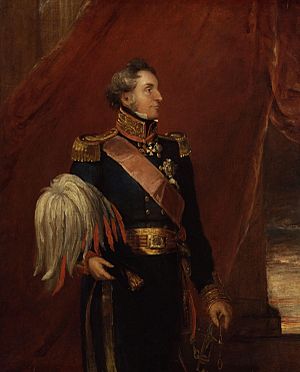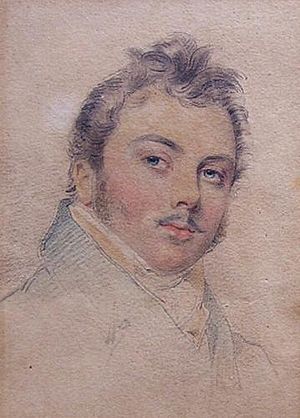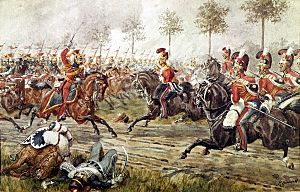Waterloo campaign: Quatre Bras to Waterloo facts for kids
Quick facts for kids Waterloo campaign: Quatre Bras to Waterloo |
|||||||
|---|---|---|---|---|---|---|---|
| Part of The Waterloo campaign | |||||||
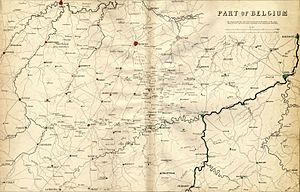 A portion of Belgium with some places marked in colour to indicate the initial deployments of the armies just before the commencement of hostilities on 15 June 1815: red Anglo-allied, green Prussian, blue French |
|||||||
|
|||||||
| Belligerents | |||||||
| Seventh Coalition: |
|||||||
| Commanders and leaders | |||||||
| Napoleon, Marshal Ney | Duke of Wellington and Earl of Uxbridge | ||||||
| Strength | |||||||
| French Army order of battle | Anglo-allied army order of battle | ||||||
After the intense fighting at Quatre Bras on June 16, 1815, the commanders, Marshal Ney for France and the Duke of Wellington for the Allies, waited for news. They soon learned that the Prussian army, led by Prince Blücher, had been defeated by Napoleon Bonaparte's French forces at the Battle of Ligny.
Hearing this, Wellington quickly planned a retreat for his Anglo-allied army. He moved them to a place near the village of Waterloo. This spot was perfect for his "reverse slope tactics," where he could hide his troops behind a hill. On June 17, despite heavy thunderstorms and pouring rain, Wellington's army successfully pulled back from Quatre Bras. They marched through the narrow pass at Genappe. The infantry went first, protected by a large group of cavalry at the back. The French chased them, but couldn't do much damage before night fell. Wellington's soldiers then set up camp on the plains of Mont-Saint-Jean.
Contents
Why the Armies Moved
After the battle at Quatre Bras, both armies camped for the night. The Anglo-allied army stayed on the battlefield, while the French were just south of them. Early on June 17, a small alarm happened when cavalry patrols accidentally met. This caused some shooting, but officers on both sides quickly calmed things down.
Wellington's Orders to Retreat
Wellington, who had spent the night in Genappe, arrived at Quatre Bras. He sent a patrol of British Hussars (light cavalry) to find out what the French were doing and where the Prussian army was. This patrol, led by Captain Grey and Lieutenant Colonel Sir Alexander Gordon, found French soldiers on the Namur road. They also found the Prussians retreating towards Wavre at a place called Tilly.
Wellington learned that the Prussians had been defeated and were moving away. This meant Napoleon had not followed up his victory as strongly as he could have. Wellington decided to retreat along the Brussels road to a strong position near Waterloo. He knew this spot well and believed he could fight a major battle there if the Prussians sent help.
He sent orders for his different army units to move:
- The 2nd and 4th British infantry divisions were to march to Waterloo.
- Other units were to gather at Braine-le-Comte or move to Hal and Brussels.
- Extra ammunition was to be moved behind Genappe.
After giving these orders, Wellington rested briefly. He was surprised by how quiet the French were, wondering if they were also retreating. Soon after, a Prussian officer confirmed their retreat to Wavre. Wellington then asked the Prussians to send two army corps to help him at Waterloo. He planned to stand and fight there.
The Allied Retreat Begins
The Anglo-allied army began its retreat carefully to hide their movements from the French. Light troops stayed at the front to cover the main army's withdrawal. The British 1st and 5th Divisions, the Dutch-Belgian 2nd Division, and the Brunswick Corps retreated in good order. They faced some delays at the narrow bridge and street of Genappe. The 3rd Division covered their retreat.
The main part of the 3rd Division started moving back around 11:00 AM. They pulled back in stages, always ready to fight if attacked. Around midday, the light troops also began to retreat slowly and steadily. To further hide their movements, all the Allied cavalry lined up behind the Namur road.
Ney's Plans and Napoleon's Advance
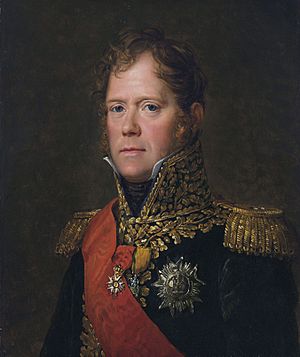
Marshal Ney, leading the French forces, didn't know the outcome of the Battle of Ligny at first. He knew Wellington's army had been reinforced. Ney thought that if Napoleon had won, Wellington would be in danger of being cut off. If Napoleon had lost, Ney didn't want to attack alone.
Ney sent a message to Napoleon asking for news. He kept his troops still, waiting for orders. Finally, he received a message from Marshal Soult confirming Napoleon's victory at Ligny. The message said Napoleon was moving towards Bry and wanted Ney to attack Wellington at Quatre Bras. Napoleon would support Ney from the side.
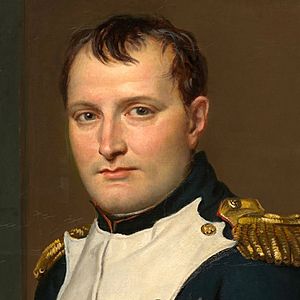
Ney then began to advance his troops. A second message from Napoleon arrived, urging him to attack Wellington and push him from his position. Napoleon himself was coming to help. When Ney saw that Wellington's infantry had already retreated, he brought forward his cavalry. He planned to attack Wellington's cavalry, which was covering the retreat.
Wellington watched the French advance. He saw large groups of French cavalry, including cuirassiers (heavy cavalry), moving forward. Skirmishes began between the French and British cavalry outposts. The British cavalry then adjusted their lines to face the advancing French.
The Allied Cavalry Retreats
Most of the Anglo-allied infantry had already crossed the Dyle river. Only a few light companies remained to cover the retreat. Earl of Uxbridge, the commander of the Allied cavalry, advised Wellington not to make a stand with the cavalry alone. Wellington agreed and told Uxbridge to organize the cavalry's retreat.
Cavalry Columns Move Back
Uxbridge divided his cavalry into three groups:
- The center column, with heavy cavalry and the British 7th Hussars, would retreat along the main Brussels road.
- The left column, with Vandeleur's and Vivian's brigades, would cross the Dyle river at a bridge further downstream.
- The right column, with other light cavalry regiments, would cross the Dyle at a ford (a shallow place to cross) upstream from Genappe.
First Skirmishes and a Storm
As the cavalry began to move, French cavalry attacked. Allied horse artillery fired back, slowing the French. Lord Vivian, leading a Hussar Brigade, pulled his men back in a line, covered by skirmishers. The French followed, shouting "Vive l'Empereur!" (Long live the Emperor!).
Suddenly, the weather changed dramatically. The air was still and hot, then a huge thunderstorm broke out. Thunder roared, and rain poured down like never before. In minutes, the ground became completely soaked and muddy, making it very hard for cavalry to move quickly. The French Lancers slowed their attack, focusing more on trying to surround the Hussars.
The Allied cavalry columns continued their retreat. The left column moved along narrow, muddy lanes towards the bridge at Thy. There was a delay as Vandeleur's Brigade hadn't crossed yet. Vivian had to send some Hussars to defend the bridge. After some skirmishing, the Hussars crossed, and dismounted men fired from the opposite bank, stopping the French pursuit. The left column then continued its retreat without further trouble towards Waterloo.
The right cavalry column also retreated in good order, crossing the Dyle at a ford. The French stopped their pursuit there, and this column also reached Waterloo safely.
The Retreat Through Genappe
The center column, with the heavy cavalry, retreated along the main Charleroi road. They took up positions on high ground behind Genappe. The 7th Hussars formed the rearguard, covering the retreat. They fought bravely, disputing every inch of ground in the muddy fields.
As they neared Genappe, the town's narrow bridge meant the cavalry had to cross in a single file. Major Hodge's squadron of the 7th Hussars fought hard to buy time. They advanced and retreated, keeping the French at bay until the rest of their troop was safe.
Fighting at Genappe
A large group of French cavalry, followed by Napoleon's main army, entered Genappe. Earl of Uxbridge wanted to slow them down. He positioned his heavy cavalry on a ridge outside the town. The French column, mostly young Lancers, became jammed in the narrow street of Genappe.
Uxbridge ordered the 7th Hussars to charge. They bravely attacked the French Lancers, but the French formed a strong, solid wall of lances, protected by the houses. The Hussars couldn't break through, and a fierce fight followed. Both the French Lancer commander and Major Hodge of the Hussars were killed. The French also brought up artillery, firing on the British.
The 7th Hussars, though brave, were eventually forced back. But they rallied and fought again, pushing the Lancers back into the town. The fight continued, showing the great bravery of the 7th Hussars. Eventually, they disengaged and reformed.
Life Guards Charge
The French, feeling confident after pushing back the Hussars, began to advance out of Genappe. They were shouting and eager to attack. However, they were moving uphill, with their sides unprotected, and the narrow town and bridge behind them.
Uxbridge saw his chance. He sent the 1st Life Guards forward. They charged downhill into the French cavalry. It was a powerful charge, smashing into the French ranks. The Life Guards completely overwhelmed the French, scattering men and horses everywhere. They chased the French through Genappe and out the other side of the town.
After the Battle at Genappe
This successful charge by the Life Guards made a big impression on the French. They became much more careful in their pursuit. The 23rd Light Dragoons then became the rearguard. The British cavalry continued to retreat slowly towards Waterloo, firing cannons and rockets at the French. The French tried to attack a few times but never got close enough to fight hand-to-hand.
Napoleon sent some cavalry to scout the area to the east. They met some Prussian dragoons, confirming the Prussian retreat.
Reaching Waterloo
French Artillery Fire
When the Allied rearguard reached the Waterloo position, the French set up two artillery batteries. They began firing on the center of Wellington's line, near the farm of La Haye Sainte.
General Thomas Picton quickly brought up two Allied artillery batteries. They fired back at the French infantry columns advancing from La Belle Alliance. The French soldiers were caught in a narrow part of the road between high banks. They couldn't move forward or backward easily and suffered heavy losses from the Allied cannon fire for about half an hour.
Evening Skirmishes
As twilight fell, the sky grew darker. Both armies sent out small groups of soldiers to set up their night positions. This led to small cavalry skirmishes. These fights didn't achieve much, but they showed the bravery of the soldiers. In one such fight, Captain Heyuger of the 7th Hussars made a brilliant charge. Another brave charge was made by Lieutenant Hugo of the King's German Legion, who rescued three carriages filled with British sick and wounded.
Wellington's Final Plans
Wellington had always thought Napoleon might try to attack his right side, near Hal, and try to capture Brussels. He had already made plans for this. He sent orders to Major General Sir Charles Colville to move his troops to Hal and defend that position. Wellington expected to fight at Waterloo the next day.
Blücher Promises Support
In the evening, Wellington received a reply from Prince Blücher. Blücher promised to come with his entire army, not just two corps. He also said that if the French didn't attack on June 18, the Allies would attack them on June 19. This was great news for Wellington.
A Rainy Night Before Battle
The soldiers set up their camps for the night. Just as the last cannon fired, a huge thunderstorm began. Loud thunder and bright lightning filled the sky. The pouring rain made the camps very gloomy and uncomfortable. Both armies spent the night on the ground that would become the famous battlefield of Waterloo.



